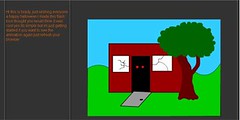To be a flash developer you actually have to wear a few different hats. There is a technical side and a creative side. For our conversation we will talk about the very basics of Flash and how we can start to think about creating a game in Flash.
On the technical side, you have to understand a little about the authoring environment that is the Flash software. It has a few key concepts that are important.
It has a stage. The stage is where all the information will be presented. It is what is viable to the audience or those that will view your finished content.
It has a timeline. This is the timing of the presentation on the stage. The timeline is broken into frames. The frames represent a unit of time that is defined by you. i.e. 24 frames per second.
There are keyframes. Keyframes represent a change that occurs on the stage. If you want something to move or change color or make a sound, you initiate or start that with a keyframe.
There are objects that go on the stage. The objects are the items that are placed on the stage. Flash provides some really cool ways to make objects efficient and it is important that you spend a little time learning about that.
There are buttons. Buttons allow the viewer (user, learner, gamer) to interact with an object on the stage. You can use buttons to create a branch in a story, gain insight from the user, or move throughout the timeline.
Watch this video about creating a button. It is about 9 minutes long and see if you can spot the stage, timeline, objects, and of course the botton (which will be quite easy.)
On the creative side, you have to think about what you want your content, i.e. objects on the stage, to look like, interact with the user, and with each other. You also need to create how the user navigates the game. You are basically the creator of an environment. You manipulate the objects to appear on the stage. We have seen this picture before, but it is a created environment.

Your goal as the developer is to create a game that removes the user from the "stage" and places them inside the environment. But don't worry you don't have to have Hollywood-skills to accomplish this goal. You just have to have a understanding of design.
Check out this really creative environment done in Flash. (Warning: stick people die in video.)

2 comments:
I've been working on my flash game design by myself, trying to come up with a working proposal. Its' a struggle, to say the least, and time-consuming, but the pay-off is that I stay abreast with what the students are learning. So I am REALLY excited about the educators chance to share and learn on Feb 1 and 2nd in Charleston! Thank you Globaloria for the support and opportunity to collaborate together. The crunch time is on for the Capital and Man groups, as we all work toward our April 19th deadline.
That's great Jenny. I can't wait to see what they come up with!
Post a Comment